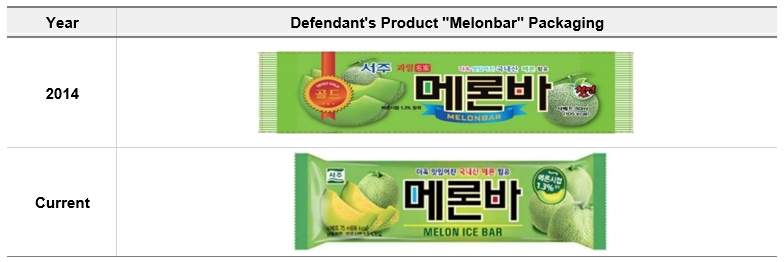A recent Seoul High Court ruling in favor of a market-leading ice cream bar brand against a competitor's copycat product is attracting considerable attention across Korea's food industry. This decision is especially relevant as "Me-Too" products are pervasive in this sector, and demonstrating similarity in packaging has been a notoriously challenging task.
Case Background
The Plaintiff's "Melona" is a melon-flavored ice cream bar, first introduced in 1992, which has long held a leading position in the market. The packaging of this product ("Plaintiff's Packaging") has evolved over time but has consistently maintained the following features since around 2004:
- A light green to green gradient background;
- The product name "Melona" prominently centered on the rectangular packaging and displayed in bold, straight black letters outlined in white for emphasis;
- An image of two whole melons positioned to the left of the product name, with images of the ice cream bar and a melon slice to the right;
- "Melon Flavored Ice Bar" in small black English text and a distinctive yellow horizontal stripe beneath the product name resembling an underline.

In contrast, the Defendant's similarly melon-flavored ice cream bar, named "Melonbar," has been sold since 2014. Over the years, its packaging has evolved to increasingly resemble the Plaintiff's design, as illustrated below:

The Plaintiff filed a lawsuit against the Defendant, seeking injunctive relief, arguing that the Defendant's packaging amounted to unfair competition under the Unfair Competition Prevention Act ("UCPA"). The Plaintiff claimed the packaging caused consumer confusion, diluted the distinctive source-identifying function of its packaging, and unfairly capitalized on the Plaintiff's business success, thereby violating the principles of fair competition.
While the first-instance court ruled in favor of the Defendant last year, the Seoul High Court overturned this decision on appeal, fully endorsing the Plaintiff's claims.
Overall Design, Not Just Individual Elements, Defines Secondary Meaning; The Famous Product Name Does Not Undermine This
The Plaintiff acknowledged that individual elements of its packaging might be common within the industry, but argued that the unique combination of these features functions as a distinctive source identifier —backed by long-term exclusive use, substantial advertising, sales exceeding 15.65 billion units since 2014, and consumer recognition confirmed by survey results.
The Defendant contended that the overall packaging image is simply the sum of standard elements that are common in the industry and that, aside from the famous product name, the packaging as a whole lacks distinctiveness.
The lower court sided with the Defendant, emphasizing that the green shades, the melon imagery, and the layout are in the public domain and not protectable on their own. It further reasoned that consumer attention was primarily drawn to the product name rather than the packaging design.
In contrast, the appellate court held that the overall combination of elements functioned as an independent source identifier as a result of the Plaintiff's exclusive, prolonged use. The court further observed that although the product name itself is highly distinctive, it also functions as a key visual element that contributes to the overall impression of the packaging design. Therefore, the distinctiveness of the product name does not preclude recognizing the distinctiveness of the packaging as a whole.
Consumer Confusion and Defendant's Intentional Copying
The appellate court found the compared packaging sufficiently similar in their shared combination of elements. The court also considered the retail environment, noting that ice cream bars are relatively inexpensive and that consumers tend to rely on the overall appearance of the packaging when selecting products from freezers stocked with various options. This was supported by the results of the Plaintiff's consumer survey in which a large majority of respondents correctly identified the Plaintiff's packaging when it was shown without the brand name, and confused the Defendant's packaging for the Plaintiff's when it was similarly presented.
Additionally, the court noted that the Defendant's modifications to its packaging which made it increasingly resemble the Plaintiff's over time demonstrated an intent to free-ride on the Plaintiff's established market presence and fame.
Based on these findings, the court concluded that the Defendant's use of its packaging was likely to cause consumer confusion and was a violation of the UCPA.
The Defendant has appealed the decision to the Supreme Court.
In the confectionery industry, it has long been common to use images of raw materials and the finished products, alongside colors associated with those materials, in packaging design to encourage purchases. This practice has fostered a widespread belief that unique confectionery packaging designs are difficult to achieve. Should the Supreme Court uphold the appellate court's ruling, it will serve as a powerful precedent to combat the prevalence of copycat products in the industry, especially as Korean foods become increasingly popular worldwide.
Related Topics
#Seoul High Court case #Packaging Distinctiveness #Trademark #UCPA #2025 Issue 3






